|
 Proliferodiscus dingleyae Proliferodiscus dingleyae
SynonymsDasyscyphus inspersus
BiostatusPresent in region - Indigenous. Non endemic
Images (click to enlarge)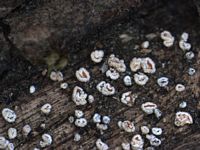
Caption: Apothecia (dry)
Owner: Herb PDD | 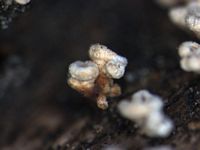
Caption: Apothecia (dry). Several discs arising from common base; receptacle pale, covered with dense, almost felted layer of hairs
Owner: Herb PDD | 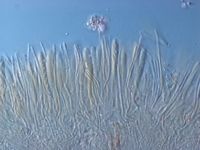
Caption: Asci, ascospores and paraphyses
Owner: Herb PDD | 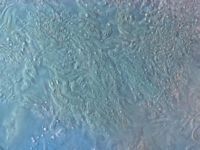
Caption: Agglutinated excipular cells
Owner: Herb PDD | 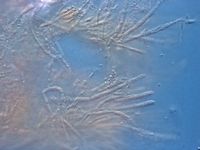
Caption: Hairs
Owner: Herb PDD | 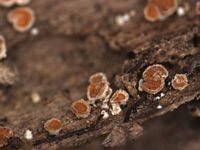
Caption: Isotype (dry)
Owner: Herb PDD | 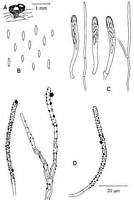
Caption: Figure 130. Proliferodiscus dingleyi, holotype. A. Proliferating apothecium. B. Ascospores.
C. Asci and paraphyses. D. Hairs. |
Article: Dennis, R.W.G. (1961). Some inoperculate Discomycetes from New Zealand. Kew Bulletin 15(2): 293-320.
Article: Spooner, B.M. (1987). Helotiales of Australasia: Geoglossaceae, Orbiliaceae, Sclerotiniaceae, Hyaloscyphaceae. Bibliotheca Mycologica 116: 711 p.
Description: APOTHECIA occurring in swarms, often clustered and deformed by mutual pressure,
frequently proliferating from the disc, superficial, short-stipitate. DISC up to 1 mm diam.,
concave, pale orange, darker and with inrolled margin when dry. RECEPTACLE shallow
cupulate, densely clothed with white hairs. STIPE short, stout, cylindric, similarly clothed
with hairs. HAIRS most 50-60 x 2.5-3.0 µm, hyaline, cylindric, straight or flexuous
particularly on the stipe, obtuse, thick-walled, coarsely granulate, bearing irregular lumps of
amorphous resinous matter up to 2.5 µm diam. ASCI 42-48(-51) x 3.5-5.0 µm, 8-spored,
cylindric-clavate, tapered below to a short, stout base, apex rounded or bluntly conical, pore
not staining blue in Melzer's reagent. ASCOSPORES 4.3-7.0 x 1.0-1.7, mean 5.7 (SD 0.7) x
mean 1.3 (SD 0.1) µm, hyaline, cylindric or cylindric-fusoid, often slightly clavate, straight,
non-septate, smooth, irregularly biseriate. PARAPHYSES hyaline, filiform, often slightly
pointed at the apex, septate, often branched below, 1.0-1.5 µm diam., exceeding the asci by up
to 10 µm. SUBHYMENIUM not clearly differentiated. MEDULLARY EXCIPULUM
composed in the receptacle of narrow, loosely interwoven hyaline hyphae 1.0-2.5 µm diam.,
more densely woven in the stipe and often broader, 2-3 µm diam., sometimes with a
dextrinoid reaction in Melzer's reagent. ECTAL EXCIPULUM up to 60 µm thick at the base
of the receptacle, narrowing towards, the margin, composed of agglutinated sub-parallel
hyphae forming narrow prismatic cells with slightly thickened walls, mostly lying at a low
angle to the surface, more irregularly arranged at the base of the receptacle and in the stipe not
differentiated as a distinct layer. Stipe tissue composed throughout of agglutinated, closely
interwoven hyphae forming interwoven hair-like hyphae at the surface and interwoven
subiculum-like hyphae ramifying onto the substrate at the base.
Habitat: On bark of Nothofagus menziesii and on rotten wood.
Distribution: New Zealand.
Notes: The holotype collection was previously reported by Dennis (1961) as Dasyscyphus inspersus
(Berk. & Curtis) Saccardo (= Proliferodiscus inspersus (Berk. & Curtis) Haines & Dumont).
Though closely related to that species, it differs in having larger asci which lack a blue pore in
Melzer's reagent, larger, less clavate spores and less flexuous hairs. However, the apothecia
proliferate from the disc in the same fashion as those of P. inspersus, and are generally very
similar in appearance. Proliferodiscus dingleyi differs from P. earoleucus (Berk. & Broome)
Haines & Dumont, which similarly has an iodine negative ascus pore, in having larger asci and
spores and in lacking the dense covering of strongly curled and interwoven hairs characteristic
of that species. The apothecia of P. earoleucus commonly have multibranched stipes but
evidently only infrequently proliferate from the disc.
Apothecia of P. dingleyi are structurally similar to those of the type of the genus,
although the subiculum -like hyphae may be scarcely evident at maturity. Nevertheless, these
hyphae can be observed in vertical section and are more obvious in young apothecia. The
excipular tissue does exhibit a dextrinoid reaction, though this is somewhat inconstant and
frequently indistinct.
|